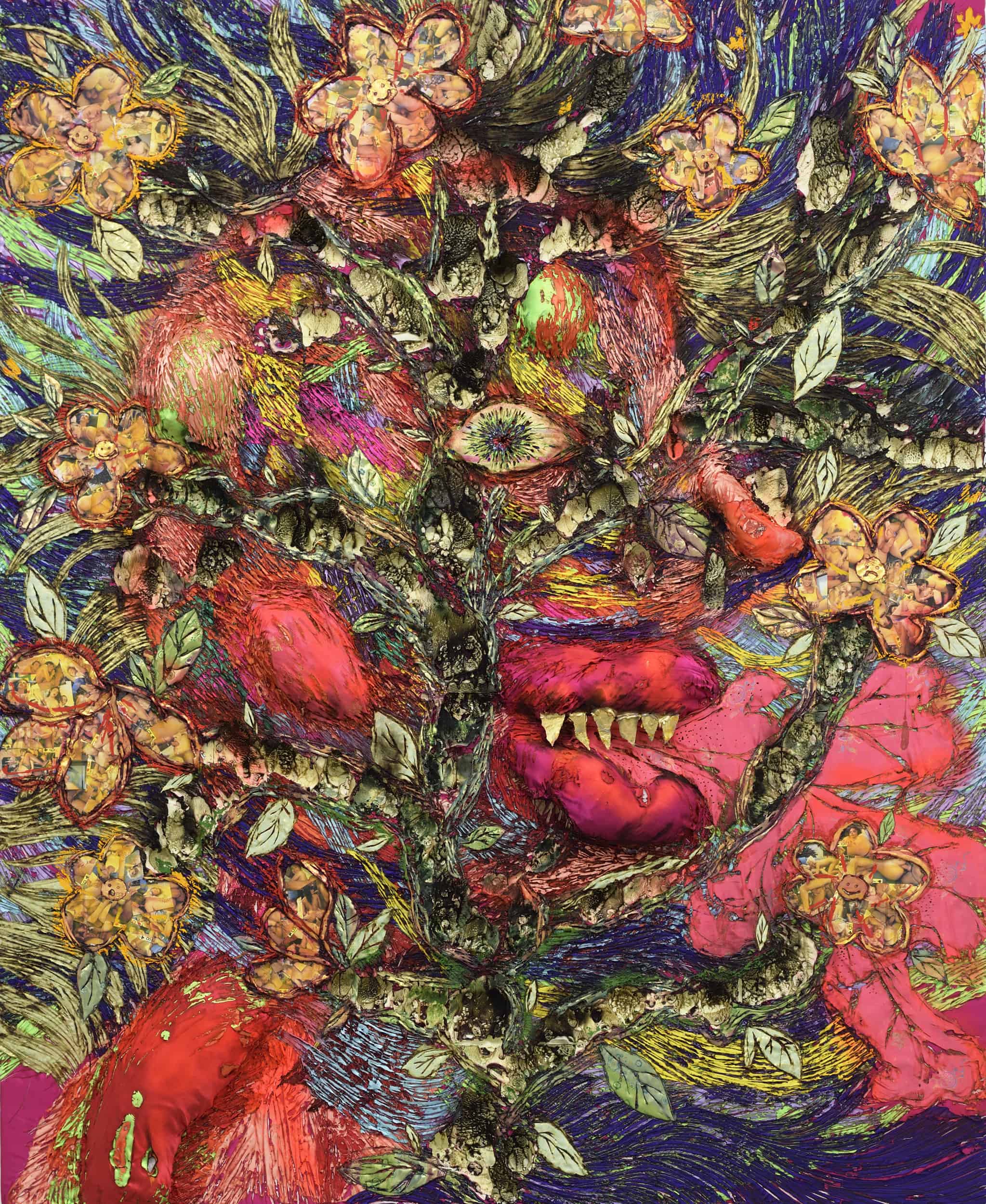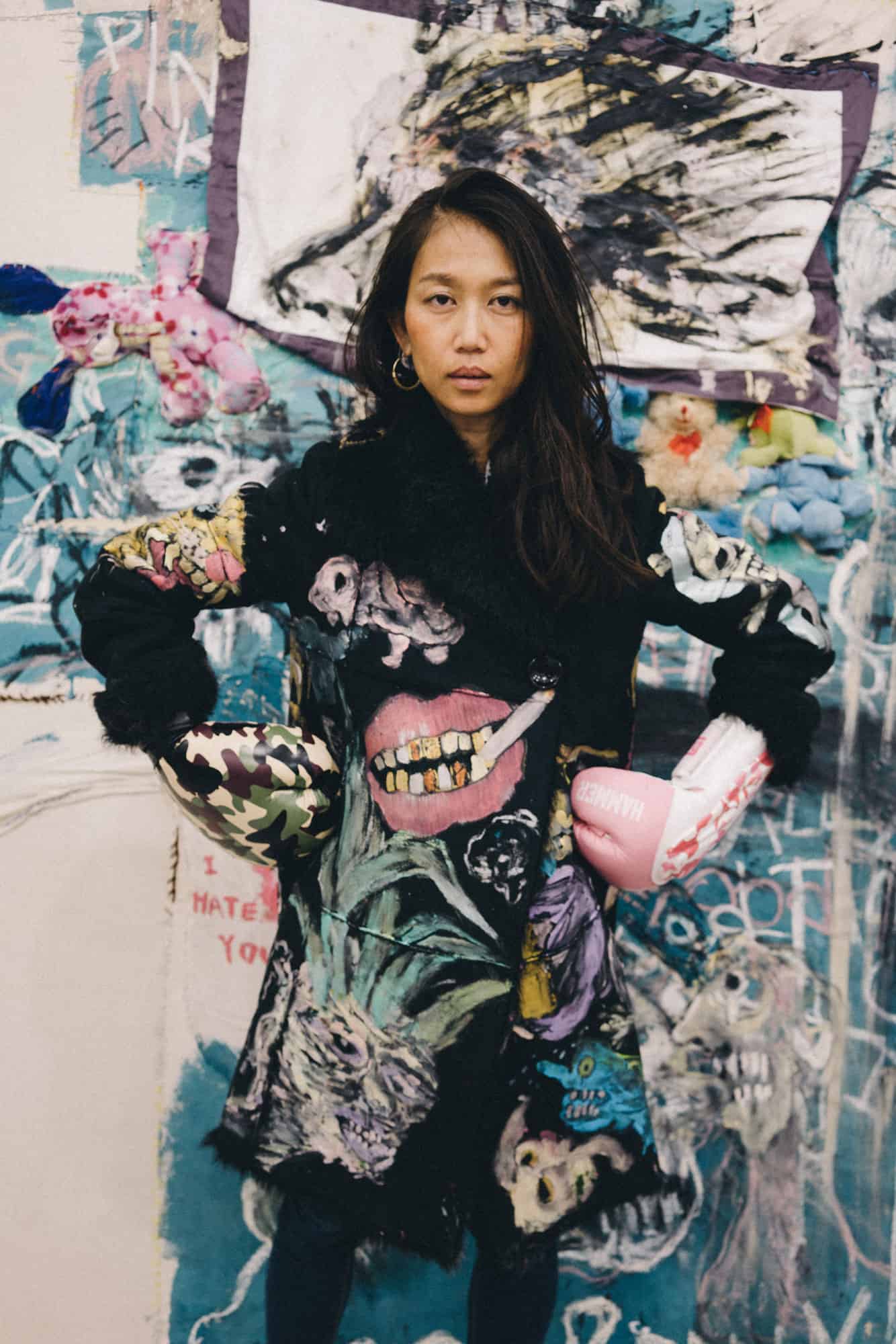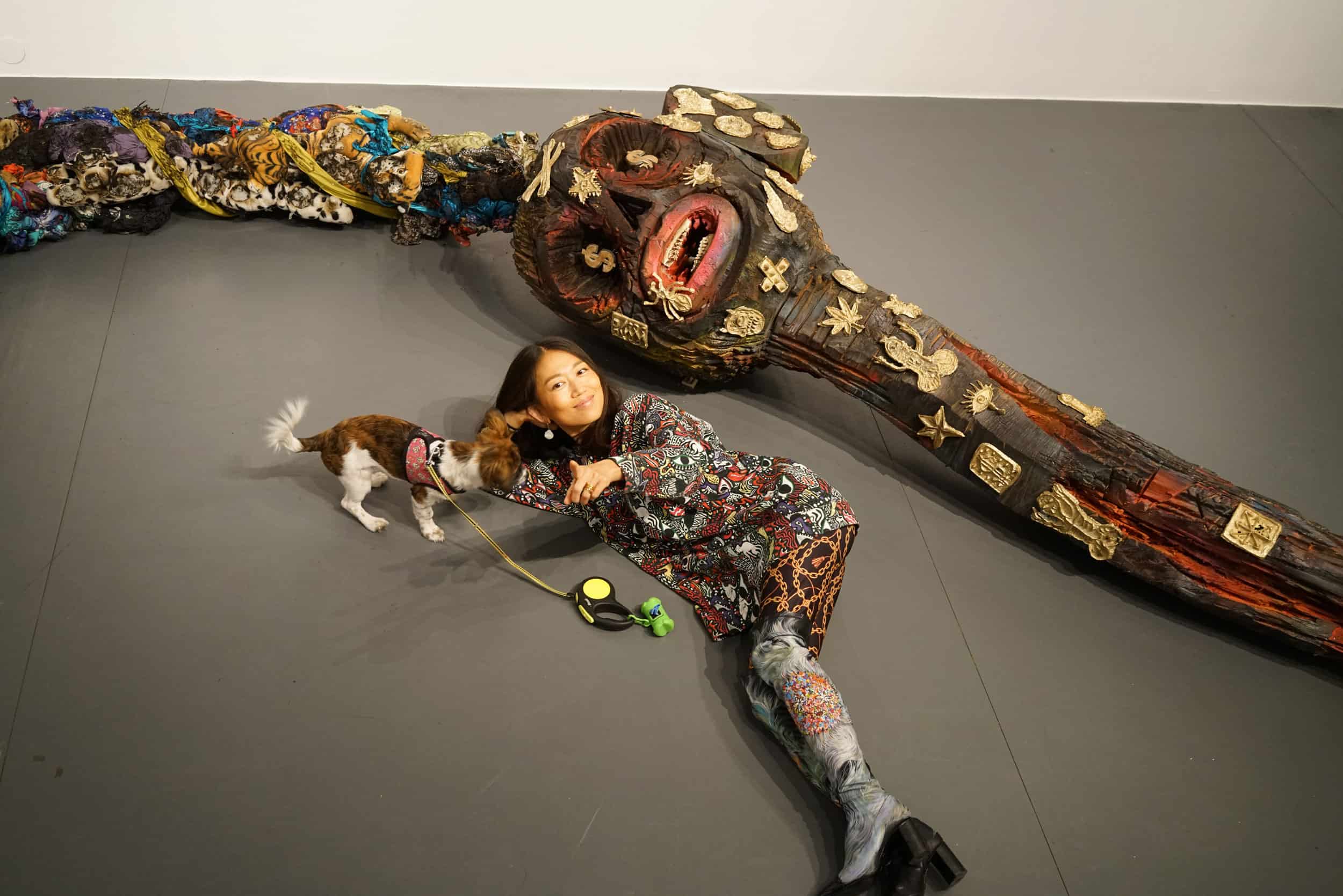Si On is known for her colourful and highly expressive works, that combine kitsch, religious and Western imagery. Often using pop culture references, her paintings are a celebration of her Asian heritage, in particular Korean shamanism, which has left a strong imprint on her paintings and what they depict. Even though bursting with colour and overwhelming spiritual energy, these pieces are not what they seem. They are driven by the artist’s fears and feelings and explore grief, anger, pain, and resentment. Beautifully seductive and seductively beautiful, they depict apocalyptic prophecies and catastrophic visions. In this interview, we discuss what inspires Si On, what has shaped her practice and what art means to her.

MM: Your work is influenced by Korean shamanism. How does it manifest in what you create?
SO: Korean Shamanism was related to the universal emotions of human beings, like happiness, sadness, love, and resentment. I am very passionate about this particular part of it and connect it to my work and life.
I believe that shamanism was deeply rooted in society and that is because of the people who desperately needed it. It represents salvation for those who believe in it. I believe that art exists for those who believe in its power. Just like that. This is quite a simple and spiritual attitude towards my work that I have always kept in my mind.
MM: I have noticed that your work is aggressive but also feminine. Apart from politics and emotions, you often talk about the experiences of Asian women and how society demands too much of them. Do you think that being a shaman gives women influence, some kind of empowerment?
SO: As a child, when I read biographies of Korean women and learned about Korean shamanism (the reason why shamanism still exists, after being treated with contempt and persecuted by other people, is because of shamans’ strength, power, and the fact that they have been involved in all these phases of people’s lives – triumphs and tragedies, from birth to death – and the role it plays in negative parts of life, like sadness, death, disease, hatred or jealousy), I’ve naturally become interested in the lower class and underprivileged people, what then led to my interests in the lives of shamans (exorcists) and Korean women in the past. In old times, the shaman was subjected to signs of contempt from other people, just as people who belonged to the lowest class in Korean society. The stories of female shamans – who had to live as both women and shamans, in a society where it was already hard enough just living as a woman, as a wife, and as a mother – are very striking. Of course, it was a long time ago and the times have changed, but some fundamental problems last until now, in a way that sexism, racism, war, and violence – which are not restricted to Korean society – supposedly seem to get better, yet the brutal reality stays the same.
„Wild heart”, 2020, mixed media, 232cm x 82cm x 60cm, Photo credit Ondrej Polak
Self portrait in front of my sculpture, “Supreme being”, 2018, wood, mixed media, 262cm x 75cm, Photo credit Jakub Julian Ziolkowski
„Pain of growth”, 2020, oil, mixed media, 340cm x 220cm, Photo credit Jakub Julian Ziolkowski
MM: What does feminism mean to you?
SO: For me, feminism is something that makes people interested in another human being and society in general, going far beyond men vs. women issues. Sometimes, I feel guilty about not raising my voice in movements against sexism and discrimination, and not getting actively involved in politics. I’m not sure why but we as artists feel pressured to have a strong sense of responsibility. People seem to enjoy talking about politics, admire getting actively involved in political movements and think that art should deal with those problems and that artists should be political. I think everything is political because we live and work in society. Even if it doesn’t seem so obvious, it is important to think about what is going on, what is the problem here, but I know I have no power over any social politics. And my work is rather on universal issues and emotions that include but are not limited to current political climates. Canvas is where I get to manifest my vision and my own state of mind. Through intense work process, I want to express any anger and negative emotions and let them all go. I cannot say that I am actively concerned about those issues. But I think that my identity as an artist and as a woman can be related to any political events and it will show through my entire artwork.
MM: What is the symbolism of hair in your works?
SO: Hair is the most symbolic and critical part of our body, as well as the origin of great imagination. Hair has always been considered as something with spiritual and vital power, it has a symbolic meaning and owes its mystery to continuous growth – because hair grows even after death and never decays. Hair is an extension of life as a human that seems to lead to a unique and separate life with a peculiar existence away from people.
Each hair, each line, leads the flow and movement of a frame. I express the symbolic meaning of hair and emotions hidden inside humans as lines. Lines raise the possibility of a symbolic object that represents mobility, dynamics, and energy occurring from the curves of hair. While I carve the curves within the frame of my work, I am absorbed into the entangled emotions represented by the passage of time, physical traces, weight, and head. Naturally tied, shiny black hair is so beautiful, while old hair fallen out on the floor looks like a corpse without the spirit. I get the impression that black female hair appeals as an escape from the social order, pain, and a sign of hardship. It represents the obsession about life getting messed up in the chaotic realm and oozing from inside while being repressed.

„I have had just enough time” (detail shots), 2020, styrofoam, wax, chewing gums, cigarettes, 126cm x 110cmx 150cm, Photo credit Ondrej Polak
MM: In interviews, you mention your mother and how she made sacrifices for you when you were a child. How did she inspire your practice and your view of the world?
SO: Since I grew up and left home to live alone, my mother was no longer just a mother, she became my best friend. And as time goes by (as she gets older), she needs my protection. The thought of how she has endured her life and sacrificed herself for me reminds me that my life is so valuable and precious, and the feeling that I get from the word ‘mother’ – a vague sense of yearning, sadness, and comfort – is the strongest force that motivates me to go through the most difficult moments in my life as a human being and as an artist.
MM: Do you consider making art a spiritual process? As something that leads to catharsis?
SO: I am a person who secretly believes in spiritual beings in my own way. I experienced something related to them, but I strongly believe that contact with spiritual beings is absolutely personal. I don’t regard making art as a spiritual process, and I feel like it’s fake to even speak of spiritual or psychological aspects of artmaking. But if you consider the spiritual process as a process that results in being absorbed in something completely, focusing all your energy on it, being separated from your surroundings, and entering a trance state without any physical assistance – then yes, I do.
When I work, I get to travel to the past. I can see the world even before I was born, and I can also see the future. I can have empathy for others, separate my emotions from my body, become a man and a woman, neither a man nor a woman, a child and an old person, neither young nor old, sad and happy, fearful and peaceful, painful and cured, confess my mistakes and forgive, hate and understand, give up and get up again. During this process – although it does not happen every time – I enter an indescribable state, which I believe is catharsis.
MM: How does this process look like? Do you plan what you want to make beforehand or is it all happening in the moment?
SO: I try to plan beforehand but nothing ever really goes as planned.

„Amulet” (detail taken from the painting), 2014, acrylic enamel, gold leaves and other mixed media on panel, 200cm x 373.5cm, Photo credit Ondrej Polak
MM: I can imagine that how you create is very dynamic. What emotions do you try to work out and process when painting?
SO: I don’t try to work out any specific emotions when I paint. I am basically drawn to the sadness and pain caused by the inscrutability, absurdity, and contradictions that human beings face in their lifetimes – to the emotions related to human unhappiness.
MM: You have lived and exhibited all around the world. How did this shape your practice?
SO: It would be an exaggeration to say ‘all around the world’ because I haven’t been to that many countries so far. I’ve settled in Poland recently and my works haven’t been exhibited worldwide yet. But I’ve been lucky to be able to live and work in completely different environments and cultures in Asia, the US and Europe. If I settled in one place and never got out of there, my work would never be the same and I doubt whether I would still be an artist. Living in different countries is one thing but traveling and getting so busy in each country is another thing.
I have moved my studio and my living space many times to different places, met so many people and had many varied experiences. Although I have lived in many countries, I never thought I was different nor did I compare myself to others, I just accepted everything that I faced. I didn’t have many questions or any reason to question. If I have to pick one, some places were more comfortable to work than others and I felt less lonely sometimes than other times. I have no idea how these experiences have affected my work, but I bet that they made me appreciate everything the way it is and everything I have. They helped me to develop flexibility so that I can work in any circumstances with time or spatial limitations, strengthen my body (because I cannot be sick) and my mental strength, and realize that I am nothing but a mere spot in this country, this planet and this galaxy.
Also, in the process of accepting this, I sometimes cried out loud, gave up and got angry when I was faced with challenges beyond my capabilities, which all made me constantly think about my identity and became the centre of my work. I had a hard time in some countries because of the language barriers (although I sometimes also had difficulties in self-expression in the cultures where people speak my mother language), but thankfully I have naturally become a gesturalist and expressionist and developed the animal instinct that helped me to overcome those obstacles.
MM: You’ve recently made a really bold decision to change your name from Hyon Gyon to Si On. What made you do that?
SO: There were so many reasons that made me want to change my name… Most of them personal. I know it’s quite complicated, since my name is also my artistic persona. It might cause confusion, but I wanted to use a name that I would feel positive about. I wanted to start over with good luck and good fortune, getting rid of bad karma that has stuck to my previous name. My new name, Si On, means truthful, right and wise, and these values have always been important for me and have shaped my attitude towards life.

„Female creature”, 2019, mixed media, satin on styrofoam, canvas, Photo credit Ondrej Polak
MM: Are there any exciting projects that you are currently working on?
SO: I’ve been excited about the exhibition that was supposed to open this April. My works for it were finished a long time ago, but they had to be transported across the sea, so they left Poland a few months ago towards Japan. However, everything got postponed because of COVID-19. I feel quite sad but it’s out of anyone’s control. I am more excited about this project because I had help from a lot of people and have spent quite a lot of time working on it. Nothing was announced about the exhibition yet, so I’d like to keep it a secret, but ‘upcoming,’ ‘catastrophe,’ and ‘doomsday’ are the main keywords. It’s going to take place soon, so I feel quite strange.
Anyways, I am waiting patiently and expecting it to open shortly while I feel a bit lazy in self-quarantine.

Self portrait in front of my work, “Big, Long, Pink”, 2019, oil, mixed media on canvas,
330cm x 238cm, Photo credit Jakub Julian Ziolkowski










